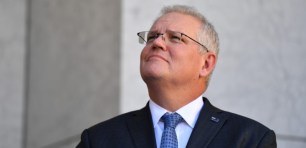
Reserve Bank governor Phillip Lowe. Source: AAP/Joel Carrett.
The Reserve Bank (RBA) has changed. It’s official now, with RBA Governor Philip Lowe announcing he intends to chase unemployment down to a new record low from its current rate of 5.8% to below 5% — perhaps even below 4% — with the goal of “full employment”.
“It’s not inconceivable we could sustain an unemployment rate starting with a three,” he remarked at a conference last week, raising the prospect of Australia returning to a level of unemployment last seen in the early 1970s.
The RBA’s focus on full employment is in full view now as we emerge from the pandemic. But the bank, once famously inflation-focused, has been talking about full employment for a while. Since, in fact, the departure of former governor Glenn Stevens.
As this chart shows, mentioning full employment was all but verboten under Stevens. Under Lowe, however, it trips from the lips of RBA officials regularly.
The bank has always had a “triple mandate”, demanding it seek price stability, full employment and the welfare of the Australian people. But for years the price stability aspect took centre stage. No longer.
Never let it be said changing the governor of the RBA is ineffective.
Handpicked for you

Cover your bases with this workplace law checklist



COMMENTS
SmartCompany is committed to hosting lively discussions. Help us keep the conversation useful, interesting and welcoming. We aim to publish comments quickly in the interest of promoting robust conversation, but we’re a small team and we deploy filters to protect against legal risk. Occasionally your comment may be held up while it is being reviewed, but we’re working as fast as we can to keep the conversation rolling.
The SmartCompany comment section is members-only content. Please subscribe to leave a comment.
The SmartCompany comment section is members-only content. Please login to leave a comment.